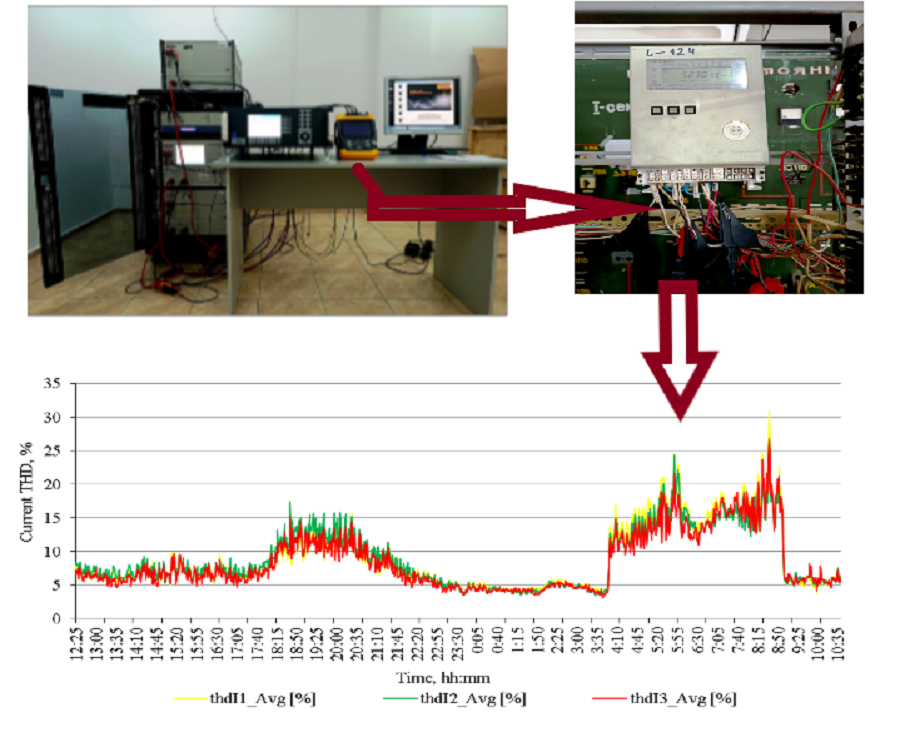Визначення впливу системних і режимних характеристик на режим втрати потужності в електричних мережах напругою 110 кВ
DOI:
https://doi.org/10.15587/1729-4061.2023.292253Ключові слова:
електричні вимірювання, втрати потужності, нелінійні спотворення, електроенергія, енергоефективністьАнотація
У даній роботі об’єктом дослідження є електричні мережі напругою 110 кВ трьох регіонів Республіки Казахстан: міста Астана, Туркестанської області та міста Шимкент, а також Західно-Казахстанської області.
Оператори досліджуваних електромереж не мають уявлення про реальні рівні коефіцієнтів спотворення синусоїдальності кривої напруги та струму, а також про їх взаємозв’язок з іншими режимними і системними параметрами електромереж. З аналогічними проблемами можуть зіткнутися інші мережеві компанії, які не мають відповідної інформаційно-вимірювальної інфраструктури для моніторингу режимів роботи електромереж з точки зору спотворення синусоїдальності кривої напруги та струму.
У ході дослідження за допомогою переносних трифазних аналізаторів кількості та якості електроенергії вдалося провести щоденні вимірювання режимних параметрів на 41 лінії електропередачі напругою 110 кВ протяжністю від 5 до 120 км.
Результати вимірювань показали, що в місті Астана якість напруги знаходиться на задовільному рівні, але коефіцієнт спотворення синусоїдальності кривої струму досягає 39 % (середній рівень за 15 дослідженими лініями становить 13,3 %) через високу концентрацію нелінійного навантаження споживачів. На півдні Казахстану коефіцієнти спотворення синусоїдальності кривої напруги та струму відносно помірні, але часто трапляються перепади напруги (іноді до 10 % і більше) через велику відстань між центрами навантаження та відносно високу щільність населення. В електромережах Західного Казахстану коефіцієнти спотворення синусоїдальності кривої напруги та струму мають високі рівні (досягають 14 % і 70 % відповідно) через низьке мережеве навантаження при великій протяжності ліній електропередачі.
Аналіз дозволяє простежити взаємозв’язок коефіцієнтів спотворення синусоїдальності кривої напруги та струму з такими регіональними характеристиками, як щільність населення, характер навантажень, втрати потужності, рівні напруги та струму
Посилання
- Velinov, E., Petrenko, Y., Vechkinzova, E., Denisov, I., Ochoa Siguencia, L., Gródek-Szostak, Z. (2020). “Leaky Bucket” of Kazakhstan’s Power Grid: Losses and Inefficient Distribution of Electric Power. Energies, 13 (11), 2947. doi: https://doi.org/10.3390/en13112947
- Zhantlessova, A., Zhumazhanov, S., Akimzhanov, T., Issabekova, B., Issabekov, Z., Mekhtiyev, A., Neshina, Y. (2023). Instrumental Research on the Voltage Harmonic Distortion Coefficient in the Modern 110 kV Urban Electric Network. International Journal on Energy Conversion (IRECON), 11 (2), 56. doi: https://doi.org/10.15866/irecon.v11i2.22979
- Assembayeva, M., Egerer, J., Mendelevitch, R., Zhakiyev, N. (2019). Spatial electricity market data for the power system of Kazakhstan. Data in Brief, 23, 103781. doi: https://doi.org/10.1016/j.dib.2019.103781
- Kazakhstan 2022. Energy Sector Review. International Energy Agency. Available at: https://iea.blob.core.windows.net/assets/fc84229e-6014-4400-a963-bccea29e0387/Kazakhstan2022.pdf
- Papyrakis, E., Parcero, O. J. (2022). The psychology of mineral wealth: Empirical evidence from Kazakhstan. Resources Policy, 77, 102706. doi: https://doi.org/10.1016/j.resourpol.2022.102706
- Ugwuagbo, E., Balogun, A., Olajube, A., Omeje, O., Awelewa, A., Abba-Aliyu, S. (2021). Experimental data on power quality assessment at point of common coupling of a steel mill to an electric power grid. Data in Brief, 39, 107681. doi: https://doi.org/10.1016/j.dib.2021.107681
- Bamigbola, O. M., Ali, M. M., Oke, M. O. (2014). Mathematical modeling of electric power flow and the minimization of power losses on transmission lines. Applied Mathematics and Computation, 241, 214–221. doi: https://doi.org/10.1016/j.amc.2014.05.039
- Norouzi, H., Abedi, S., Jamalzadeh, R., Rad, M. G., Hosseinian, S. H. (2014). Modeling and investigation of harmonic losses in optimal power flow and power system locational marginal pricing. Energy, 68, 140–147. doi: https://doi.org/10.1016/j.energy.2014.02.010
- Panda, D. K., Das, S. (2021). Smart grid architecture model for control, optimization and data analytics of future power networks with more renewable energy. Journal of Cleaner Production, 301, 126877. doi: https://doi.org/10.1016/j.jclepro.2021.126877
- Ali, A. O., Elmarghany, M. R., Abdelsalam, M. M., Sabry, M. N., Hamed, A. M. (2022). Closed-loop home energy management system with renewable energy sources in a smart grid: A comprehensive review. Journal of Energy Storage, 50, 104609. doi: https://doi.org/10.1016/j.est.2022.104609
- EN 50160:2010. Voltage characteristics of electricity supplied by public electricity networks. Available at: https://standards.iteh.ai/catalog/standards/clc/18a86a7c-e08e-405e-88cb-8a24e5fedde5/en-50160-2010#Text
- -2014 - IEEE Recommended Practice and Requirements for Harmonic Control in Electric Power Systems. doi: https://doi.org/10.1109/ieeestd.2014.6826459
- Raihan, A., Tuspekova, A. (2022). Dynamic impacts of economic growth, energy use, urbanization, agricultural productivity, and forested area on carbon emissions: New insights from Kazakhstan. World Development Sustainability, 1, 100019. doi: https://doi.org/10.1016/j.wds.2022.100019

##submission.downloads##
Опубліковано
Як цитувати
Номер
Розділ
Ліцензія
Авторське право (c) 2023 Temirbolat Akimzhanov, Yermek Sarsikeyev, Assemgul Zhantlessova, Serik Zhumazhanov, Zhanibek Baydulla, Bibigul Issabekova, Zhanat Issabekov, Ali Mekhtiyev, Yelena Neshina

Ця робота ліцензується відповідно до Creative Commons Attribution 4.0 International License.
Закріплення та умови передачі авторських прав (ідентифікація авторства) здійснюється у Ліцензійному договорі. Зокрема, автори залишають за собою право на авторство свого рукопису та передають журналу право першої публікації цієї роботи на умовах ліцензії Creative Commons CC BY. При цьому вони мають право укладати самостійно додаткові угоди, що стосуються неексклюзивного поширення роботи у тому вигляді, в якому вона була опублікована цим журналом, але за умови збереження посилання на першу публікацію статті в цьому журналі.
Ліцензійний договір – це документ, в якому автор гарантує, що володіє усіма авторськими правами на твір (рукопис, статтю, тощо).
Автори, підписуючи Ліцензійний договір з ПП «ТЕХНОЛОГІЧНИЙ ЦЕНТР», мають усі права на подальше використання свого твору за умови посилання на наше видання, в якому твір опублікований. Відповідно до умов Ліцензійного договору, Видавець ПП «ТЕХНОЛОГІЧНИЙ ЦЕНТР» не забирає ваші авторські права та отримує від авторів дозвіл на використання та розповсюдження публікації через світові наукові ресурси (власні електронні ресурси, наукометричні бази даних, репозитарії, бібліотеки тощо).
За відсутності підписаного Ліцензійного договору або за відсутністю вказаних в цьому договорі ідентифікаторів, що дають змогу ідентифікувати особу автора, редакція не має права працювати з рукописом.
Важливо пам’ятати, що існує і інший тип угоди між авторами та видавцями – коли авторські права передаються від авторів до видавця. В такому разі автори втрачають права власності на свій твір та не можуть його використовувати в будь-який спосіб.










